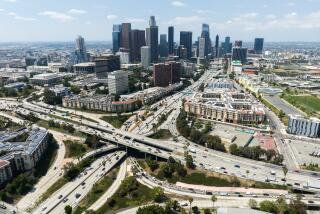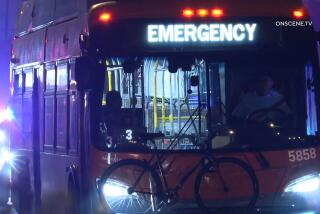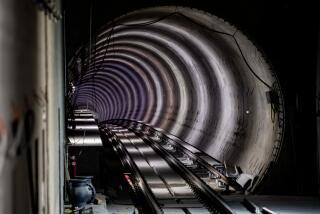Valley Commentary : It’s High Time for MTA to Get Itself on the Right Track : The beleaguered transit agency has been derailed by budget and service problems since its formation. Its board needs to end the backbiting and to cut waste.
- Share via
The Metropolitan Transportation Authority, the agency responsible for building and operating Los Angeles’ rail and bus transit systems, is in trouble.
Its Metro Rail project is running $200 million over budget, making our subway mile for mile the costliest built in the United States in recent years. The cost of some subway construction contracts has ballooned by as much as 81% over the competitively bid price.
The wheels on our subway cars are wearing out too soon. And many segments of the subway tunnel are walled with concrete that is four to six inches thinner than designed (and four to six inches thinner than paid for)--possibly reducing the subway’s chances of withstanding a major earthquake.
These are just MTA’s subway problems. They’ve got trouble elsewhere, too.
*
MTA buses are criticized as unsafe, dirty and covered with graffiti. Due to the agency’s high administrative costs and outdated work rules, these buses cost more to run than cleaner, safer ones in many surrounding cities. Yet MTA has been slow to resolve these problems, and as a result we will soon have to consider burdening commuters with fare increases, service reductions or both.
Recent news reports have focused on excessive expenditures by MTA board members and staff on junkets, dinner and doughnuts. The agency has bought into questionable financing schemes with offshore Caribbean banks. It has tried to bypass money-saving competitive bidding in the selection of investment bankers.
MTA expects to face a $126-million operating shortfall for the 1994-95 fiscal year. In fact, the agency has experienced operating shortfalls for the past three years, and has closed the gap each time by using reserve funds instead of cutting costs. For 1994-95, there are no reserve funds left and so far no consensus on the tough choices that lie ahead.
MTA was created by merging the old Southern California Rapid Transit District with the Los Angeles County Transportation Commission. There was hope that this would create a more effective organization that would be able to cut costs, provide more efficient service and put an end to constant feuding between what were then rival agencies. However, MTA has been slow to realize the benefits of consolidation, maintaining duplicate staff in many areas, including lobbying, for several months after the merger took place. Even today, duplication, backbiting and power plays remain the norm.
*
So what is the MTA board doing to address these concerns? Not nearly enough. The board itself is practically paralyzed by lobbyists and is close to breaking down under its own weight.
MTA board members may not vote on matters involving most campaign contributors (and MTA alternates, like myself, are also prohibited from voting on matters involving anyone who contributed to the appointees for whom they serve as alternates). Inasmuch as there are more than 1,200 lobbyists registered at MTA, every vote of consequence on the board is an exercise in lunacy.
*
The fact that MTA is the only government agency in town with money to spend is not lost on our lobbyist friends. Competition for MTA business is so intense that wanna-be contractors and lobbyists can subscribe to not one but two private newsletters detailing MTA affairs. When I walked into my first MTA board meeting, the “lobbying energy” in the room was so thick you could cut it with a campaign check. Is this how we want transportation decisions made?
The conduct of the MTA board is problematic too. When I was first elected to the City Council, I was joining an institution with a structure and established rules to follow. The MTA, in contrast, is about as orderly as the Wild West. There are no rules and no protocol. The board is overwhelmed with minutiae and regularly underbriefed on the items--often worth millions of taxpayer dollars--on which it must decide.
To its credit, MTA management is starting to pull itself out of the morass. We now have a strong chief executive officer, Franklin White, who is trying hard to rein in the beast. We have a first-rate inspector general who will be on the lookout for corruption and waste. With the help of the news media we have begun to focus public attention on MTA.
*
Much more remains to be done. MTA must end the backbiting, streamline operations, cut out waste, eliminate duplicate functions and institute the normal governmental checks and balances. This means reforming the board process by establishing rules of procedure and strict disclosure of lobbying activity, scheduling more frequent board meetings and eliminating the alternates who now double the size of the already-cumbersome 13-member board. MTA must get its fiscal house in order. It must spend and commit to spending only those tax dollars it has to spend. It must put a stop to hanky-panky in the contracting process by establishing a protocol that is firm, fair and free from question.
This is a tall order, but MTA must do it if the public is to gain confidence in this most important local agency.
More to Read
Sign up for Essential California
The most important California stories and recommendations in your inbox every morning.
You may occasionally receive promotional content from the Los Angeles Times.










